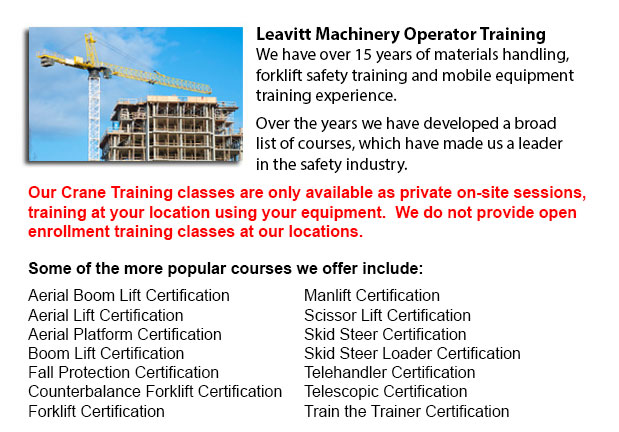
Ontario Crane Operator Classes - Crane operator training is for supervisors and operators of overhead lifting machinery. The course is suitable for both current and new operators. Course content includes applicable federal, provincial and state safety regulations. The first part of training comprises comprehensive in-class instruction and examination. After that is a hands-on customized session along with practical lessons and assessment.
Course content applies to all categories and types of overhead lifting equipment. Specific instruction will concentrate on aspects of crane operation utilized at the trainee's workplace. Upon completion of the course, trainees would know how to operate particular overhead lifting machines, attachments and related parts efficiently and safely.
The operator course's goal is to first identify and potentially dangerous operator habits that can develop when a person operates an overhead crane. Costly damage to equipment and products can be prevented with right practices. Training lessens the chance of a workplace injury or incident taking place.
The duration of the course is eight hours of classroom instruction followed by a few hours of customized, on-site, hands-on training. Participants would be graded on their knowledge of training material through an assessment of their practical knowledge and written testing. The minimum acceptable score is 80%.
In the in-class session, participants will know applicable guidelines and legislation, causes of occurrences and damages, internal responsibility, hazard awareness, design principles and basic equipment, capacity ratings/load weight calculations, pre-shift equipment inspections, safe hoisting/operating methods, equipment applications/rigging, types of hardware, angles and hitches, operator/pedestrian safety, flipping/turning loads safely, hand signals for slingers and operators.
The practical training and evaluation portion of the course must be pre-scheduled. This customized portion of the training will be held at the trainees' facility. The length of this practical training component is an hour or two. Two operators at a time would be trained by the instructor about skills like for instance planning the lift, proper rigging practices and safe operation.
After completing both the practical training and evaluation and the in-class instruction, the trainee will be tested via an exam. Each and every participant would be needed to sign the safety rules. Individual wallet certificates would be given to trainees who are successful. A framed wall certificate would be provided to the company.
-
Ontario Manlift Certification
Ontario Manlift Certification - The Elevated Platforms and Manlifts Certification course helps to provide the required training on the work practices, safe operating procedures, regulations and rules regarding the everyday activities for the operator... More -
Ontario Crane Training
Ontario Crane Training - Bridge cranes or overhead cranes are actually a type of industrial material handling crane making use of a line and hook mechanism that runs on a horizontal beam running along two widely separated rails. Various overhead cran... More -
Ontario Aerial Lift Train the Trainer
Ontario Aerial Lift Train the Trainer - The Aerial Lifts Train the Trainer Certification Program teaches trainers how to effectively train operators in safe industrial mobile machinery operation. Trainers are given in-depth instruction about aerial l... More -
Ontario Warehouse Forklift Training Classes
Ontario Warehouse Forklift Training Classes - The reason for warehouse training classes are to raise the awareness of common workplace dangers. The trainees will learn essential warehouse safety procedures. An emphasis is placed on paying attention t... More -
Ontario Forklift Training School
Ontario Forklift Training School - Forklift Training School - Industry and federal regulators have established the criteria for forklift safety training based on their current standards and regulations. Those wanting to operate a forklift must finish... More -
Skid Steer Loader Training in Ontario
The engine powered skid-steer loader consists of a rigid and small frame, equipped along with lift arms that could attach to lots of industrial tools and attachments to execute many labor saving jobs. Normally, skid-steer loaders are four-wheel drive... More -
Ontario Crane License
Ontario Crane License - Crane operators ought to be "credentialed", that means they ought to own a crane operator certification or license. Credentialing is considered a mandatory governmental requirement to be able to practice as an operator of a cr... More -
Ontario Forklift Operator Training
Ontario Forklift Operator Training - Forklift training is a prerequisite in North America and is intended to prevent workplace injuries and death. Forklift training offers driver training intended for forklift operators. Training programs teach the s... More

Forklift Certification Ontario
TOLL FREE: 1-888-254-6157
Toronto, Ontario
forkliftcertificationontario.com
Email Us
About Us


